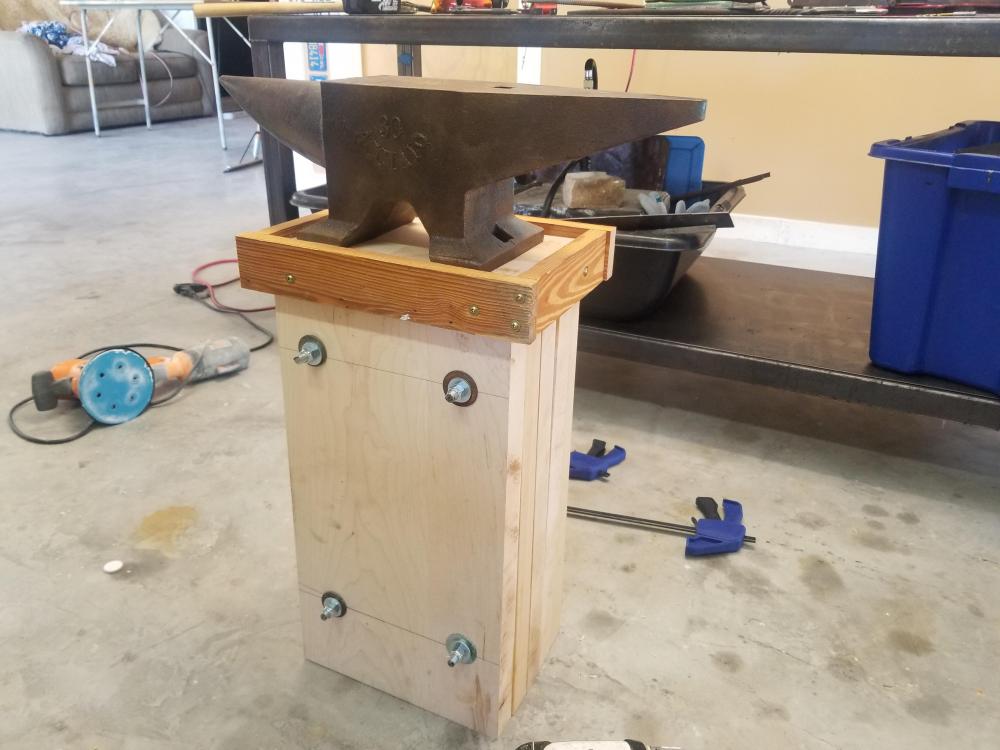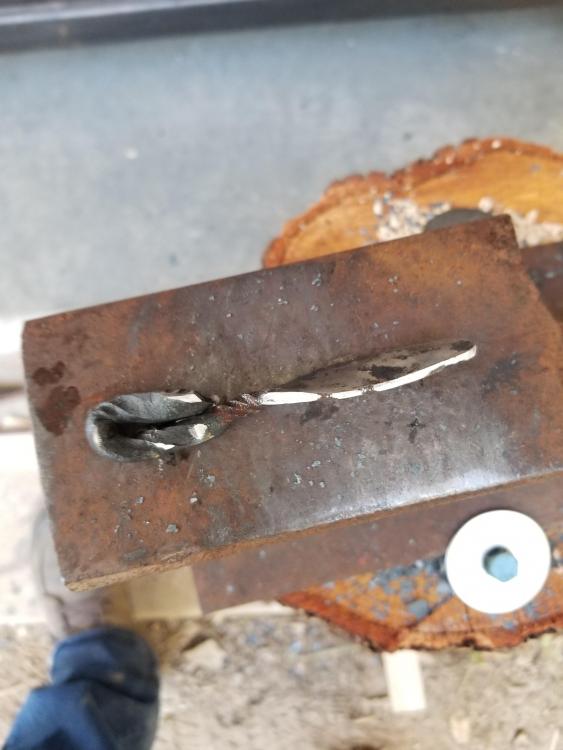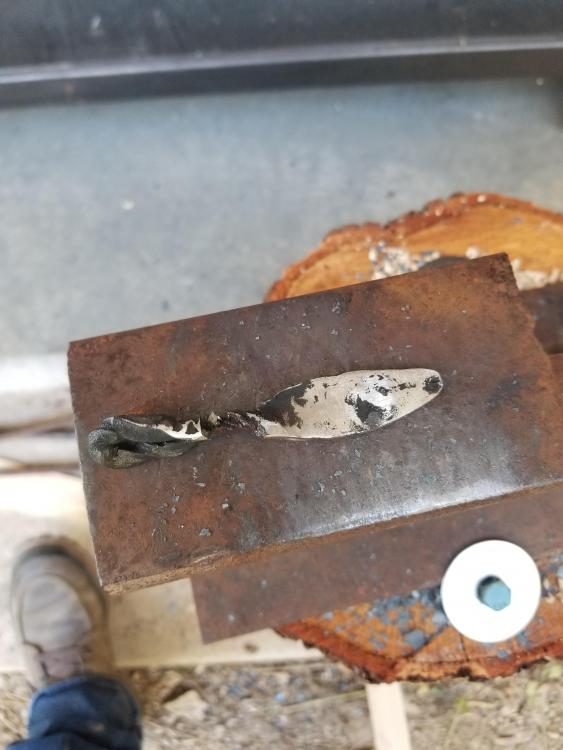
Bleu86
Members-
Posts
33 -
Joined
-
Last visited
Profile Information
-
Gender
Male
-
Location
Cedar Park, Texas, USA
-
Interests
Smithing, Knives, Photography, Rock Climbing, Cycling, Outdoor Recreation, Camping, Cooking
Recent Profile Visitors
The recent visitors block is disabled and is not being shown to other users.
-
What did I do wrong? I'm trying to bring out my first hamon. After hand sanding it up to an 800 grit finish I submerged it in the FeCl, a total of three 10 (ish) minute soaks, with a 0000 steel wool scrub between each. After the final soak I neutralized with baking soda and then scrubbed with dish soap and water. The knife was now rough to the touch. I began sanding at 800 grit again but to get the knife to feel smooth again, I had to basically sand past all of the activity the etch brought out, while other areas just wouldn't seem to polish up at all. The hamon in particular seemed like a never ending source of oxide streaks, despite being nearly as faint as it was before etch. I finally gave up and took it back to the belt grinder to bring it back to raw steel (this thing is gonna be a fillet knife by the time I'm through). I'll start the hand sanding journey again tomorrow. I'm sure i did something wrong. I know I didn't get the knife as clean as I thought, there were a few blotchy spots, but those were separate from the worst areas that wouldn't polish. Was my FeCl too concentrated? Did I leave it in too long? Not long enough? Ferric was labeled as "ready to use" in the bottle but I diluted it roughly 50/50 with water. No pics because I didn't think to document anything until I was almost done at the grinder.
-
Almost done with stand for the 66lb happybuy
Bleu86 replied to Bleu86's topic in Stands for Anvils, Swage Blocks, etc
Started out doing that, but quickly found that I was just chasing high spots and it would only be level for the one area of floor I was working on. Its going to be moving around quite a bit, so I'll need something that will be solid anywhere it goes. Right... can't believe I didn't think of a 3-pointed base. I used to discuss their merits in regards to telescopes on a regular basis when I helped with astronomy programs. T-nuts and feet are already ordered, but I think I'll just put 3 on. Thanks for the input everyone. Much appreciated. -
Almost done with stand for the 66lb happybuy
Bleu86 replied to Bleu86's topic in Stands for Anvils, Swage Blocks, etc
There's the rub. It's a mixed use shop, and things get moved around a lot. It won't always be in the the same spot, so I can't shim it for a particular location. -
Almost done with stand for the 66lb happybuy
Bleu86 replied to Bleu86's topic in Stands for Anvils, Swage Blocks, etc
Ive been trying to upload one but it's not working. Maybe this link will... Not trying to get it perfectly evel, just need it not to rock back and forth. -
Stand is 5 pieces of walnut countertop (scrap leftover from a remodel) glued/bolted together. We got the top true so the anvil sits doesn't rock, but the bottom is pretty jagged. We lack the tools to plane it smooth, so planning on using 1/2" T nuts and feet designed to level pool tables, which should have the added bonus of allowing it to be more portable and sit evenly wherever it is. Anyone have any experience with a similar set up?
-
Thank you, don't know how I missed that!
-
I assume this is a regular question but I couldn't find it anywhere. Does anyone have a favorite online source for abrassives? Started trying to find some different belts and it's a jungle.
-
Hey, I know fayette county! Used to work in Bastrop! I recently lit up my forge in awhile and let my steel soak for a bit. BIG difference.
-
Thanks everyone! I'm in a shaded outdoor area in central Texas. I'm not worrying much about preheating the anvil, lol! Apart from that, it sounds like there's a lot of small tweaks I can make to improve workable heat time. Speaking of New Mexico, I've spent a lot of time in the Pecos wildernesses. Love that area, but man, talk about some temperature swings! Only place I've been that has changed as much in one day was Hueco Tanks. 40+ degree changes in a day.
-
That was kinda what I was asking. Material seems to be getting plenty hot, but maybe it's not as hot as I think it is? Losing heat to inefficient technique makes sense too. Nothing to do there but keep working on it till i can do it right! I'm going to try leaving the steel in for much longer too and see if that helps. Thank you so much for the feedback.
-
What did you do in the shop today?
Bleu86 replied to Mark Ling's topic in Blacksmithing, General Discussion
Second ever attempt to forge something. Both times shooting for a leaf key fob. Not pretty but I learned a lot (like my steel forearms from weekly rock climbing no longer exist and I need a lighter hammer ). All in all I'm calling today a win. -
Hello all, I had my second try at forging a simple leaf today and (after copious study at the University of YouTube.. WHAT UP ALEC STEELE). I made vast improvements over last time and I'm still figuring out how to handle a hammer and shop setup to maximize efficiency (and by shop I mean a gas forge on a roller table and a broken railroad track bolted to a log), but what I'm finding is that my metal is cooling way faster than it seems to do in the videos. As I watch the various YouTube videos, the crafters are able to calmly speak and work for several minutes while the steel is till glowing. I'm getting 4-5 hammer blows in before it starts getting dark. I know videos do a questionable job of transmitting what color you're really looking for, but even at bright yellow color to my eye, it get very little time. I'm working on a single venturi burner rectangular forge with stone/firebrick baffles on both ends. After the forge is hot, I'm leaving 3/4 inch mild steel round in for about 5 minutes and not really seeing much color change after the first couple of minutes. Thanks yall.
-
Any day I make someone laugh is a good day!
-
A friend has asked for a celtic armband. She has made her whole ren faire outfit by hand so it doesn't need to look fancy but its a relatively large radius. I figured filling it with concrete would add some heft, reduce vibration, and improve efficiency. (I used to have burly rock climber arms, but since having kiddos I am small and weak)
-
Sorry if this is the wrong location for this post. Im just starting out and my "anvil" right now is a small piece of railroad track. There's not enough room to cut and grind a horn, so I'm trying to figure out an alternative. One thought was to hammer down a round pipe (which I have plenty of) into a taper and fill it it with concrete. Opinions? Note: this will be for small projects only.


